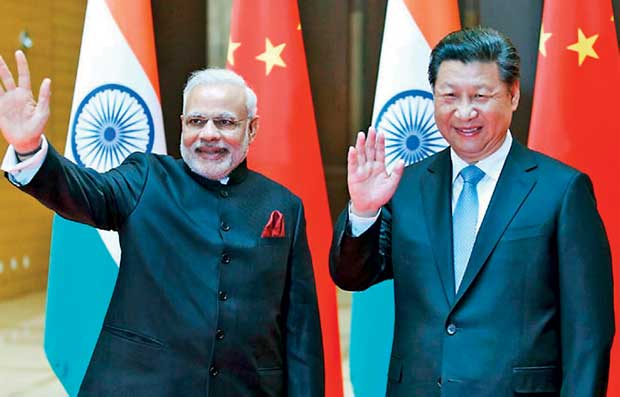09 Jan 2018 - {{hitsCtrl.values.hits}}

 The old economic order is dead but India and China must take the lead to preserve its successes.
The old economic order is dead but India and China must take the lead to preserve its successes.
Eighteen years ago, as the millennium drew to a close, the annual ministerial meeting of the World Trade Organisation (WTO) in Seattle in the US was derailed by the fury of thousands of street protestors denouncing the forces of globalisation and the governments which represented them.
Last month, at the dusk of 2017, a ministerial meeting of the WTO in Buenos Aires, Argentina ended in a whimper with the US leading a general apathy towards free trade and globalisation. Perhaps 2017 will be remembered as the year when the liberal economic consensus on free markets and globalisation was finally buried in its homelands, the US and UK. One wonders though what the street protesters of Seattle make of the cast of characters administering the last rites to the ‘Washington Consensus’. Not Fidel Castro or Hugo Chavez or even Lula da Silva but instead a Republican President of the US, who also happens to be a billionaire and a powerful faction of the Conservative Party of the UK. For the global Left, the ‘victory’ must be bittersweet.
Three decades of success
For ordinary citizens of the world, the ideological and policy shifts in the advanced economies, particularly post-Trump America and post-Brexit Britain, are likely to be more bitter than sweet. Consider the view from emerging economies. No other period in human history has seen as many people lifted out of absolute poverty as in the three decades since the mid-1980s. That is largely because the world’s two most populous nations, China and India, made rapid strides in terms of economic growth in this period.
China, which embraced openness and internal reform more vigorously than India, has been the bigger beneficiary. India, with its limited openness and gradual internal reform process, registered lower growth than China but higher growth rates than any other point in its history.
It would be cynical to say that the forces of globalisation and free markets have only enriched a minority in these countries. The fact is that more than half a billion people have been lifted out of poverty in a single generation by the very forces that are now being buried in the countries of their origin.
This is not to argue that there were no flaws in the system. The role of Wall Street and global finance in bringing disrepute to the system is well known. That is what precipitated the 2008 financial crisis, which sowed the seeds for a backlash. But curiously, politics has chosen to target free trade and free (only relatively) movement of labour, soft targets compared to the powerful world of finance. There is a grave danger for both emerging economies and advanced economies with this form of backlash. In the advanced economies, it is convenient to blame free trade for job losses in manufacturing, without commenting on the huge benefits such trade has brought for consumers who are clearly better off as a result of cheaper products and services. It is easy to target immigrants without acknowledging the huge value-add they bring to the host economies.
Think of the number of foreign-born persons in top positions in American or British academia or in Silicon Valley. Without them, the US (even the UK) would not be so wealthy. Any sustained backlash against free trade and immigration will ultimately hurt the economic and geo-political interests of the US and UK.
Still, the advanced economies may be wealthy enough to delay the day of reckoning. For countries like India and several other emerging and developing economies, a closed world means missed opportunities and a longer journey out of poverty for those who continue to remain poor. They have the most important stake in ensuring that the world doesn’t return to wealth-destroying autarky.
Pegged to reforms
However, before batting for openness abroad, emerging economies need to put their houses in order. For many emerging economies, particularly China and India, the backlash against free markets isn’t likely to stem from external considerations (free trade or free movement of labour) but from a free market system at home that has been vitiated by crony capitalism.
It isn’t surprising that the leaders of both China and India, President Xi Jinping and Prime Minister Narendra Modi, have devoted a considerable amount of political capital to combat corruption and root out entrenched vested interests.
It isn’t an easy task and it won’t happen overnight but the battle against corruption and cronyism is a critical element in retaining the legitimacy of an open market economy, which has delivered more prosperity than any alternative system in the last hundred years. In India, the battle against graft has to be accompanied by an attempt to improve state capacity because there are certain critical functions which only the state can perform.
Reform at home must be accompanied by a willingness to open up to the rest of the world. China has been aggressive about exports and about attracting foreign investment but has been more protectionist about imports (particularly services and agricultural goods) and its state-owned enterprises. India has never quite embraced an export-oriented development strategy.
Somehow the point that the domestic market is large enough has won the argument even when it is apparent that the global market is several times that size. Just the global market for merchandise trade is US $ 18 trillion, almost nine times the size of India’s total gross domestic product. India needs to capture a much larger share of that market than its present 1.6 percent share.
India also needs to capture a greater share of foreign investment. But for that to happen, it needs to give up its traditionally defensive posture on trade in particular. The opportunity has never been better as China’s wages rise and it reorients its economic strategy from primarily an export-led growth to a more consumption-driven economy.
India and China hold the key to the emerging global political economy. Joining the US and other advanced economies in closing up will only lead to slower growth.
The challenge for India and China, as the two fastest growing major economies, is to engage with each other and with other willing partner nations, particularly in the East Asia and Pacific region (including advanced economies like Japan and Australia), to maintain openness and embrace globalisation.
The Regional Comprehensive Economic Partnership (RCEP) is one forum where this engagement can happen. India can engage on free trade and free investment in other groups like the BBIN (Bangladesh, Bhutan, India and Nepal) and BIMSTEC (Bangladesh, India, Myanmar, Sri Lanka, Nepal, Thailand and Bhutan) and via these groups with the entire ASEAN region.
The scenario is set for an Asian century. But for it to materialise India, China and the rest of the region need to look beyond rivalry and defensiveness to explore the possibilities of economic integration as the West, so dominant for the last two hundred years, marginalises and isolates itself. That is the promise of 2018 and beyond.
(Dhiraj Nayyar is Officer on Special Duty and Head, Economics, Finance and Commerce, NITI Aayog, Government of India)
04 Jan 2025 3 hours ago
04 Jan 2025 3 hours ago
04 Jan 2025 5 hours ago
04 Jan 2025 5 hours ago
04 Jan 2025 5 hours ago